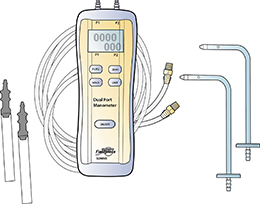How To Measure Coil Static Pressure Drop
When evaluating the performance of evaporator airflow, you need to use a monometer with a static pressure tip and hose to connect them. When installing a new coil, it is a best practice to install your test port in a location that avoids the refrigerant tubing before the coil installation.

Going one step further, for a low additional cost, you can install a permanently mounted static pressure tip to avoid any mechanical damage caused by repeatedly inserting static pressure tips during maintenance visits.
First, determine a location to install a static pressure port. Depending on what type of equipment you are testing, you should verify your probe will not come in contact with belts, capacitors, or other electrical components.
In an existing system, you may not be confident as to what is behind the panel and may not want to drill through it.
In these cases, you can install a test port in the side of the furnace, test through the limit switch hole, or use a section of capillary tubing to measure the pressure entering the coil through the gap in the corner of the furnace’s exiting opening flange.
When you have the pressure entering and exiting the coil, subtract exiting pressure from entering pressure to calculate the evaporator coil pressure drop expressed by the symbol ‘p.
Solutions For Coil Pressure Drop Problems
To solve pressure-drop problems with evaporator coils, you need to identify and control the source of the problem. Some common problems begin with a poor coil choice, filter bypass, as well as return duct leakage.
Another problem source is incorrect airflow. This leads to insufficient condensation on the coil to remove particulate buildup.
Occasionally you may come across excessively low coil pressure drop. Typically, you need to look for a bypass around the coil.
Other things to look for include missing panels inside the coil and along the sides of the coil, or gaps between the drain pan and outer casing.
There are several solutions to correct an evaporator coil that has an excessive pressure drop.
The most effective way is to install coils that can move the correct airflow at a low-pressure drop. One evaporator coil manufacturer, for example, offers three-ton coils at an airflow of 1200 cfm that have a range of static pressure drop from .2′ to .4?. By knowing the operating pressure drop, we can select the coil rated at .2′ and ensure we meet the pressure budget for a system with a PSC motor rated at .5?.
Click Below for Next page:













Recent Comments